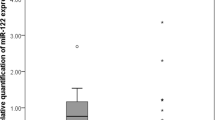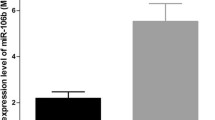Abstract
The liver transplant (LT) situation represents an attractive model for studying hepatocellular carcinoma (HCC) metastasis. Based on microarray data, we previously found that miR-126 expression was lower in tumor tissues of patients with post-LT HCC recurrence compared with non-recurrence. In this study, we examined the expression of miR-126 in HCC samples from 68 patients who had undergone LT using quantitative real-time PCR and analyzed its correlation with clinicopathological features and prognosis of patients. Furthermore, we performed experimental analyses to explore the involvement of miR-126 in HCC metastasis. We found that miR-126 levels were lower in tumor tissues of patients with post-LT HCC recurrence in comparison to patients with no-recurrence (p = 0.009). Lower expression of miR-126 in HCC was associated significantly with tumor recurrence (p = 0.011) and poor survival (p = 0.009) of patients. Functional studies indicated that ectopic expression of miR-126 significantly inhibits HCC cells migration, invasion, proliferation and colony formation in vitro, and suppresses experimental lung colonization in vivo. Our study revealed that down-regulation of miR-126 plays an important role in HCC metastasis, and suggest a potential application of miR-126 in prognosis prediction and HCC treatment.



Similar content being viewed by others
Abbreviations
- HCC:
-
Hepatocellular carcinoma
- LT:
-
Liver transplant
- miR(s):
-
MicroRNA(s)
- qRT-PCR:
-
Quantitative real time-polymerase chain reaction
- FFPE:
-
Formalin-fixed paraffin embedded
- MET:
-
Mesenchymal epithelial transition
- OS:
-
Overall survival
References
El-Serag HB, Rudolph KL (2007) Hepatocellular carcinoma: epidemiology and molecular carcinogenesis. Gastroenterology 132(7):2557–2576
Parkin DM, Bray F, Ferlay J, Pisani P (2005) Global cancer statistics, 2002. CA Cancer J Clin 55(2):74–108
Thomas (2010) Hepatocellular carcinoma: consensus recommendations of the national cancer institute clinical trials planning meeting (vol 28, pg 3994, 2010). J Clin Oncol 28(36):5350–5550
Hanahan D (2000) The hallmarks of cancer. Cell 100(1):57–70
White NMA, Fatoohi E, Metias M, Jung K, Stephan C, Yousef GM (2010) Metastamirs: a stepping stone towards improved cancer management. Nat Rev Clin Oncol 8(2):75–84
Bartel DP (2009) MicroRNAs: target recognition and regulatory functions. Cell 136(2):215–233
Bartel DP (2004) MicroRNAs: genomics, biogenesis, mechanism, and function. Cell 116(2):281–297
Ambros V (2004) The functions of animal microRNAs. Nature 431(7006):350–355
Ventura A, Jacks T (2009) MicroRNAs and cancer: short RNAs go a long way. Cell 136(4):586–591
Iorio MV, Croce CM (2009) MicroRNAs in cancer: small molecules with a huge impact. J Clin Oncol 27(34):5848–5856
Valastyan S, Reinhardt F, Benaich N et al (2009) A pleiotropically acting microRNA, miR-31, inhibits breast cancer metastasis. Cell 137(6):1032–1046
Korpal M, Ell BJ, Buffa FM et al (2011) Direct targeting of Sec23a by miR-200s influences cancer cell secretome and promotes metastatic colonization. Nat Med 17(9):0–8
Schlitt HJ, Neipp M, Weimann A et al (1999) Recurrence patterns of hepatocellular and fibrolamellar carcinoma after liver transplantation. J Clin Oncol 17(1):324–331
Han ZB, Zhong L, Teng MJ et al (2012) Identification of recurrence-related microRNAs in hepatocellular carcinoma following liver transplantation. Mol Oncol 6(4):445–457
Yao FY, Ferrell L, Bass NM et al (2001) Liver transplantation for hepatocellular carcinoma: expansion of the tumor size limits does not adversely impact survival. Hepatology 33(6):1394–1403
Anglicheau D, Sharma VK, Ding R et al (2009) MicroRNA expression profiles predictive of human renal allograft status. Proc Natl Acad Sci 106(13):5330–5335
Gupta GP, Massagué J (2006) Cancer metastasis: building a framework. Cell 127(4):679–695
Esquela-Kerscher A, Slack FJ (2006) Oncomirs—microRNAs with a role in cancer. Nat Rev Cancer 6(4):259–269
Garzon R, Calin GA, Croce CM (2009) MicroRNAs in cancer. Annu Rev Med 60:167–179
Huang S, He X (2010) The role of microRNAs in liver cancer progression. Br J Cancer 104(2):235–240
Ma L, Teruya-Feldstein J, Weinberg RA (2007) Tumour invasion and metastasis initiated by microRNA-10b in breast cancer. Nature 449(7163):682–688
Bhaumik D, Scott G, Schokrpur S, Patil C, Campisi J, Benz C (2008) Expression of microRNA-146 suppresses NF-κB activity with reduction of metastatic potential in breast cancer cells. Oncogene 27(42):5643–5647
Wong CCL, Wong CM, Tung EKK et al (2011) The MicroRNA miR-139 suppresses metastasis and progression of hepatocellular carcinoma by down-regulating Rho-Kinase 2. Gastroenterology 140(1):322–331
Yao J, Liang L, Huang S et al (2010) MicroRNA-30d promotes tumor invasion and metastasis by targeting Galphai2 in hepatocellular carcinoma. Hepatology 51(3):846–856
Budhu A, Jia HL, Forgues M et al (2008) Identification of metastasis-related microRNAs in hepatocellular carcinoma. Hepatology 47(3):897–907
Wong QWL, Lung RWM, Law PTY et al (2008) MicroRNA-223 is commonly repressed in hepatocellular carcinoma and potentiates expression of stathmin 1. Gastroenterology 135(1):257–269
Huang XH, Wang Q, Chen JS et al (2009) Bead-based microarray analysis of microRNA expression in hepatocellular carcinoma: miR-338 is downregulated. Hepatol Res 39(8):786–794
Tavazoie SF, Alarcon C, Oskarsson T et al (2008) Endogenous human microRNAs that suppress breast cancer metastasis. Nature 451(7175):147–152
Liu B, Peng XC, Zheng XL, Wang J, Qin YW (2009) MiR-126 restoration down-regulate VEGF and inhibit the growth of lung cancer cell lines in vitro and in vivo. Lung Cancer 66(2):169–175
Feng R, Chen X, Yu Y et al (2010) miR-126 functions as a tumour suppressor in human gastric cancer. Cancer Lett 298(1):50–63
Hamada S, Satoh K, Fujibuchi W et al (2011) miR-126 acts as a tumor suppressor in pancreatic cancer cells via the regulation of ADAM9. Mol Cancer Res. doi:10.1158/1541-7786.mcr-11-0272
Mazzaferro V, Regalia E, Doci R et al (1996) Liver transplantation for the treatment of small hepatocellular carcinomas in patients with cirrhosis. N Engl J Med 334(11):693–699
Acknowledgments
This study was supported by National Key Technology R&D Program (2008BAI60B03).
Conflict of interest
The authors disclosed no commercial or financial interest in the subject of study.
Author information
Authors and Affiliations
Corresponding author
Additional information
H. Chen, R. Miao and J. Fan contributed equally to this study.
Rights and permissions
About this article
Cite this article
Chen, H., Miao, R., Fan, J. et al. Decreased expression of miR-126 correlates with metastatic recurrence of hepatocellular carcinoma. Clin Exp Metastasis 30, 651–658 (2013). https://doi.org/10.1007/s10585-013-9569-6
Received:
Accepted:
Published:
Issue Date:
DOI: https://doi.org/10.1007/s10585-013-9569-6




